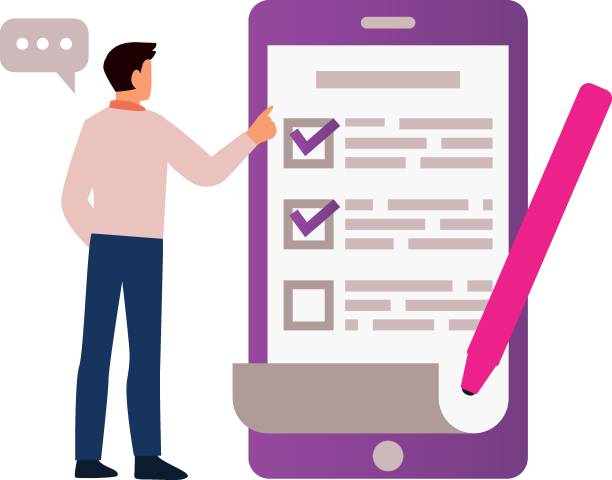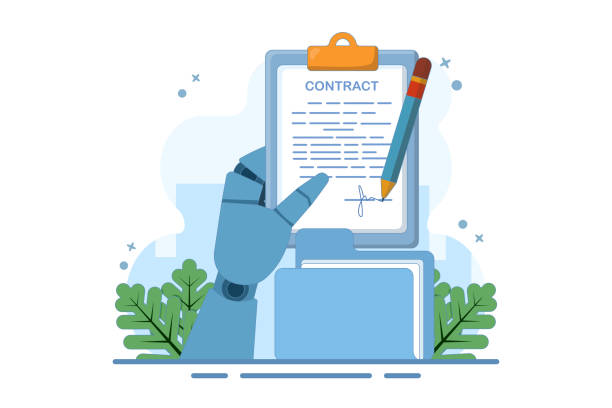Importance of Global Expansion with Multilingual Website Design

In today’s world, where geographical boundaries have lost their meaning in the digital space, #multilingual_website_design is no longer a luxury option, but a strategic necessity for any business looking to expand its reach and access international audiences.
A single-language website can only cover a small fraction of the global market; while the ability to provide content in various languages opens new doors to emerging markets and potential customers worldwide.
This approach not only increases accessibility but also sends a clear message to the audience: “We value you and speak your language.” This can significantly boost customer trust and loyalty.
Many companies have realized that ignoring non-English speaking markets means losing countless opportunities for growth and revenue.
Global audiences prefer to receive information in their native language, and this is an undeniable fact.
Multilingual websites enable businesses to convey their message in a culturally appropriate way to their target audiences.
This goes beyond a simple translation; it involves localizing content, adhering to cultural customs, and considering subtle linguistic nuances that can profoundly impact #user_experience and conversion rates.
Optimizing a website for multiple languages not only helps with greater visibility in search engines but also provides a basis for deeper engagement with users.
This comprehensive approach ensures long-term success in the global arena and allows companies to compete in new markets and create a sustainable competitive advantage.
Are you losing business opportunities due to an outdated website? With Rasawwb, permanently solve the problem of not attracting potential customers through your website!
✅ Attract more high-quality leads
✅ Enhance brand credibility in the eyes of customers
⚡ Get free consultation for corporate website design
Competitive Advantages of Multilingual Website Design for Businesses

Multilingual website design is not just a necessity, but a powerful competitive advantage for businesses seeking to advance in the global arena.
The first and most important advantage is increased market access.
By providing content in various languages, companies can reach millions of new users worldwide who were previously overlooked due to linguistic barriers.
This expansion of reach means a potential increase in customers, sales, and revenue.
Furthermore, a multilingual website enhances brand credibility and image internationally.
When a company invests in speaking its audience’s language, it demonstrates respect and commitment to global customers, which in turn boosts trust and loyalty.
This advantage is especially crucial in competitive markets.
From a #search_engine_optimization (SEO) perspective, multilingual sites offer unique opportunities for #higher_ranking in search results across different languages.
By targeting language-specific keywords, the website can also perform better in local search engines for that language, ultimately leading to more and higher-quality organic traffic.
This is particularly vital for businesses looking to attract local customers in other countries.
Additionally, increased #conversion_rate is another key advantage.
When users can read product or service information in their native language, they are more likely to feel comfortable and confident, and ultimately make a purchase decision.
This localized user experience eliminates linguistic and cultural barriers and simplifies the decision-making process for the customer.
Ultimately, multilingual website design allows companies to better understand the needs of different markets, precisely adjust their marketing strategies, and provide a more appropriate response to global customer demand.
Challenges and Technical Considerations in Multilingual Website Design

One of the most complex aspects of #multilingual_website_design is managing numerous technical challenges that need to be carefully considered.
These challenges include choosing the URL structure (subdomain, subdirectory, or top-level domain), correctly implementing hreflang tags to inform search engines about different language versions, and selecting an appropriate Content Management System (CMS) that supports multilingualism.
Each of these choices will significantly impact SEO performance and user experience.
For example, using subdirectories (like example.com/fr) is generally recommended for SEO, as it shares the main domain’s authority, whereas subdomains (fr.example.com) might require independent SEO.
The table below shows some of the most important technical considerations and their solutions:
| Technical Challenge | Description | Suggested Solution |
|---|---|---|
| URL Structure | Choosing between subdomain, subdirectory, or TLD domain. | Using subdirectories (example.com/fr) for better SEO. |
| hreflang Tag | Specifying language and regional versions of content. | Correctly implementing hreflang tags in HTML header or XML sitemap. |
| CMS Support | Does the chosen CMS support multilingual content management? | Using CMSs like WordPress with WPML or Drupal with multilingual modules. |
| Language Switching | Providing an easy way for users to change language. | Using a clear dropdown menu in the header or footer. |
Additionally, choosing appropriate web hosting is also important.
The hosting must be able to handle traffic load from global users and utilize servers near the target audience to increase site loading speed.
Also, the issue of localizing images, videos, and other media elements should not be overlooked.
Visual content may also need translation or localization to be compatible with different cultures.
Multilingual website design requires a comprehensive technical approach that covers all these aspects to ensure the correct and optimal performance of the site in all languages.
Search Engine Optimization (SEO) for Multilingual Websites

Search Engine Optimization (SEO) for multilingual sites has its own complexities that go beyond mere keyword translation.
The main goal is for search engines (like #Google and Bing) to identify different language versions of a website and display them to the appropriate users, based on their language and location.
One of the most important tools for this purpose is the correct use of the hreflang tag.
This tag informs search engines which version of a page is intended for which language and/or geographical region.
Incorrect use or neglect of this tag can lead to duplicate content issues and harm the site’s ranking.
In addition to hreflang, choosing the appropriate URL structure is crucial in multilingual SEO.
As mentioned earlier, using subdirectories (like example.com/es/) is often preferred for SEO due to sharing the main domain’s authority.
However, using country-code Top-Level Domains (ccTLDs) like example.es or example.de can also be beneficial for stronger geographical targeting, although their management might be more complex.
#Keyword_research in each language should be done independently.
Keywords popular in one language may not have the same meaning or popularity in another.
Local translators and SEO specialists must work together to find appropriate and localized keywords that target audiences use in each language.
Also, it’s important that the translated content is of high quality and not just a machine translation.
Content should be localized, natural, and appealing to native readers.
Google and other search engines can detect content quality and give higher rankings to higher-quality content.
Building local links for each language version can also help improve rankings.
Acquiring links from reputable websites in each country or region signals to search engines that your website is authoritative in that specific market.
In summary, a comprehensive SEO strategy for #multilingual_website_design requires a multi-faceted approach that includes technical techniques, high-quality and localized content, and a local link-building strategy to ensure the website is properly seen in each target market and reaches its full potential.
Are you worried about your e-commerce site’s low conversion rate and not achieving your desired sales?
Rasawwb is your specialized solution for a successful e-commerce website.
✅ Significant increase in conversion rates and sales
✅ Professional and user-friendly design to satisfy customers
⚡ Ready to revolutionize your online sales? Get a free consultation!
Efficient Content Management and Translation Processes

One of the most important pillars of success in #multilingual_website_design is efficient content management and translation processes.
Mere literal translation of content is not enough; it requires cultural localization, terminology, and even the writing tone for each target language.
This process must be carried out by native and specialized translators who not only have complete fluency in the language but are also familiar with the culture, local idioms, and even common jokes in that region.
Using machine translation alone, though fast and inexpensive, usually does not provide the necessary quality for professional website content and can harm brand credibility.
To manage the large volume of content on a multilingual website, using Translation Management Systems (TMS) or multilingual features within a CMS is essential.
These systems help you organize the translation process, track different language versions, and facilitate collaboration between content writers and translators.
Tools like Translation Memory (TM) and Terminology Database (TB) can help improve the consistency and quality of translations over time, and also reduce translation costs.
TM stores previously translated sentences so that re-translation is not needed if they recur, and TB ensures that key terms and branding are translated consistently across all languages.
The translation process should include strict #quality_control_steps, including review by another native speaker, functional testing of the site in different languages, and final review to ensure content accuracy and fluidity.
Also, updating content on a multilingual site can be challenging.
Whenever the original content is updated, the translated versions must also be updated.
Having a clear #content_update_policy and accountability for each language is essential.
This systematic approach to content management and translation processes helps your website consistently provide accurate, relevant, and high-quality content to its users worldwide and achieve the full potential of multilingual website design.
User Experience (UX) in Multilingual Website Design

User Experience (UX) plays a vital role in the success of #multilingual_website_design.
An excellent multilingual site goes beyond merely providing translation; it must understand users in every language and culture and address their needs.
The first principle is easy and accessible #language_switching_capability.
Users should be able to easily select their desired language at any point on the site.
This option is usually provided via a clear dropdown menu or country flags in the site’s header or footer.
It’s important not to use flags alone to represent languages, as a flag represents a country and not necessarily a language (for example, Spanish is spoken in several countries).
In addition to language switching, the site’s design and layout must be adaptable for #different_readers.
For example, languages like Arabic and Persian are read from right to left, whereas most European languages are left to right.
This difference necessitates redesigning the User Interface (UI) for right-to-left languages to maintain readability flow.
Also, text length may vary across different languages; an English sentence that fits on one line might require two or three lines in German or Spanish.
Responsive and flexible design is essential to accommodate these changes so that the site’s appearance does not break in any language.
Localization is not limited to text; images, videos, and even icons must also be culturally appropriate.
An image or icon acceptable in one culture might be inappropriate or confusing in another.
#Colors also have different meanings in various cultures and must be chosen carefully.
Date, time, currency, and phone number formats should also be localized to make users feel more comfortable.
Providing customer support in different languages is also a big plus for increasing #user_satisfaction.
Ultimately, successful multilingual website design requires a deep understanding of cultural and linguistic differences to provide a seamless and enjoyable user experience for all global audiences and contribute to business growth.
Architecture and Technical Implementation of Multilingual Website

The architecture and technical implementation of multilingual website design are the cornerstones of its stability and proper functionality.
This section includes critical choices and decisions regarding infrastructure, database, and programming logic that severely impact user experience and SEO.
Choosing a Content Management System (CMS) that natively supports multilingual capabilities is the first crucial step.
CMSs like Drupal, Joomla, or specialized platforms such as Contentful or Sitecore, offer built-in language management capabilities, while for WordPress, using powerful plugins like WPML or Polylang is essential.
These CMSs allow you to manage content, menus, categories, and even SEO settings separately for each language.
Another key aspect is how multilingual content is stored and retrieved in the database.
There are various methods for this, including creating separate columns for each language in a single table, or creating entirely separate tables for each language.
Each method has its advantages and disadvantages, but the ultimate goal is to ensure scalability and ease of content management over time.
Also, using translation APIs and automation tools can speed up the content update process, but they always require human oversight and review to maintain quality.
Correct implementation of localization (L10n) and internationalization (I18n) features in the website code is also essential.
This includes using Unicode for supporting various characters, formatting dates and times based on region, and managing currency.
The table below shows the main techniques for implementing multilingual content:
| Implementation Technique | Advantages | Disadvantages |
|---|---|---|
| Subdirectory (example.com/es/) | SEO friendly, easy maintenance, domain authority sharing. | Less recognizable for users at first glance. |
| Subdomain (es.example.com) | Easy indexing in webmaster tools, identifiable. | May require separate SEO. |
| Top-Level Domains (example.es) | Strong geographical targeting, high local trust. | Higher cost and maintenance, need for multiple domains. |
| URL Parameter (example.com?lang=es) | Easy implementation, simple management. | Weak SEO, duplicate content, difficult for users. |
Choosing the correct architecture not only impacts how users interact with the site but also how it is crawled and indexed by search engines.
Ultimately, multilingual website design technically requires precise planning, the use of appropriate tools, and collaboration between development, content, and SEO teams to create a robust and scalable platform for global presence.
Common Mistakes in Multilingual Website Design and Their Solutions

In the #multilingual_website_design process, common mistakes can render efforts fruitless and harm site performance.
Awareness of these mistakes and finding appropriate solutions for them is a significant step towards success.
One of the biggest mistakes is the sole use of machine translation without human review.
While tools like Google Translate can be useful as a starting point, they cannot grasp cultural nuances, local idioms, and appropriate tone.
This leads to unnatural, humorous, or even offensive content that damages brand credibility.
The solution is to always use native and specialized translators and to perform a thorough review and localization process.
Another mistake is ignoring multilingual SEO.
Many businesses simply translate content and expect search engines to automatically display it in target markets.
But without using hreflang tags, localized keyword research, and local link building, the website will not be visible in search engines for those languages.
The solution is to design a comprehensive SEO strategy for each language and consider all its technical and content aspects.
Also, not choosing the appropriate URL structure (subdirectory, subdomain, or TLD) can confuse search engines and users.
The table below shows some other common mistakes:
| Common Mistake | Explanation | Solution |
|---|---|---|
| Lack of visual element localization | Images, icons, and colors not accepted in a culture. | Review and localize all visual elements based on the target culture. |
| Unclear language switcher menu | Users cannot easily change the language. | Placing a clear language selector in the header/footer. |
| Lack of Right-to-Left (RTL) support | Layout issues for languages like Persian and Arabic. | Implementing RTL design and thorough UI testing. |
| Forgetting to update content | Not updating translated versions after original content changes. | Establishing a regular update process and accountability. |
Finally, ignoring technical requirements such as appropriate hosting for global traffic load or lack of Unicode support in the database can lead to performance issues and incorrect character display.
Success in #multilingual_website_design requires a comprehensive approach and attention to detail to ensure an excellent user experience and optimal performance in all target markets.
Are you tired of your company website not meeting your expectations? With Rasawwb, design a professional website that truly represents your business.
✅ Increased attraction of new customers and sales leads
✅ Enhanced credibility and trust for your brand among your audience
⚡ Get a free website design consultation!
Measuring Performance and Success of Multilingual Websites

After implementing and launching a multilingual site, a crucial step often overlooked is measuring its performance and success.
Simply having a website in multiple languages does not guarantee success; specific metrics must be defined to evaluate its #Return_on_Investment (ROI) and effectiveness.
Web analytics tools like Google Analytics play a vital role in this stage.
By correctly setting up reports, data related to users of each language can be monitored separately.
Metrics such as number of visitors, Bounce Rate, time spent on site, and Conversion Rate for each language should be carefully examined.
In addition to quantitative metrics, #qualitative_feedback from users is also very valuable.
This feedback can be gathered through in-site surveys, user reviews, or focus groups.
Understanding how users interact with content in different languages, what sections confuse them, and what their expectations are, can help with continuous improvement of user experience and content.
Observing user behavior through heatmaps and session recordings can also provide deep insights into navigation issues or confusing sections in different language versions.
For #multilingual_SEO, monitoring keyword rankings in local search engines of each country is essential.
SEO tools can show you how your website ranks for localized keywords in each language.
This monitoring helps identify weaknesses in the SEO strategy and find new opportunities for improvement.
Also, the amount of referrals from local sites and the volume of organic traffic from different geographical regions should be examined.
Multilingual website design is a continuous process and requires ongoing optimization and improvement even after launch.
By collecting and accurately analyzing data, businesses can ensure the effectiveness of their investment and adjust their strategies for sustainable growth in global markets.
Future of Multilingual Website Design and Emerging Trends

The future of #multilingual_website_design is rapidly evolving, with many emerging trends shaping this field.
One of the most important of these trends is the advancement of #Artificial_Intelligence (AI) and Machine Learning in translation.
While machine translation alone is not yet a substitute for human translation, AI algorithms are improving at an astonishing rate.
These technologies can accelerate the translation process, increase #translation_accuracy, and even help automate content localization, although human oversight will remain essential.
Also, we are witnessing an increased use of Headless CMS platforms that manage content independently of its display.
This approach provides greater flexibility for delivering content across various languages and channels (such as web, mobile, IoT devices, and voice assistants) and simplifies the multilingual content management process.
With the expansion of voice assistants and #voice_search, multilingual websites must also prepare to respond to these types of interactions.
This means optimizing content for voice responses and ensuring that information is correctly understood and delivered by voice assistants in multiple languages.
The increased use of #Virtual_Reality (VR) and Augmented Reality (AR) also creates new opportunities for multilingual website design.
Interactive and multimedia content in these environments must also be provided in a multilingual and localized manner to offer an immersive user experience for global audiences.
Furthermore, the focus on personalized user experience is growing.
Multilingual websites in the future will be able to personalize content and products based on each user’s language preferences, geographical location, and even browsing history.
This level of personalization significantly increases user engagement and helps boost conversion rates.
Ultimately, multilingual website design is moving towards smarter, more automated, and more personalized systems.
Businesses that embrace these trends will be able to compete in global markets and achieve greater success.
This dynamic and evolving field constantly offers new opportunities for innovation and reaching new audiences worldwide.
Frequently Asked Questions
| Question | Answer |
|---|---|
| What is a multilingual website? | It is a website whose content is available to users in several different languages. |
| Why should we design a multilingual website? | To expand access to international audiences, increase website traffic, improve SEO in target markets, and provide a better user experience for non-Persian speaking users. |
| What are the main methods for implementing a multilingual website? | Using a subdomain (e.g., en.mysite.com), using a subdirectory (e.g., mysite.com/en/), and using separate domains for each language (e.g., mysite.com and mysite.de). |
| Which implementation method is better for SEO? | Generally, using a subdirectory (language folder) is often recommended due to the transfer of the main domain’s authority to other languages. |
| What is the Hreflang tag and what is its purpose? | It is an HTML tag or HTTP Header that informs search engines which version of a page is suitable for which language or geographical region. This tag prevents duplicate content and improves SEO. |
| How is a language switcher designed? | Usually by using a dropdown menu, button, or flag in the site’s header or footer, which allows the user to select their desired language. |
| Is automatic (machine) translation suitable for a multilingual site? | No, machine translation usually has low quality and many errors that can harm the site’s credibility. Human translation or a combination of human translation and machine editing is recommended. |
| What are the most important SEO tips in multilingual website design? | Correct use of the Hreflang tag, having an appropriate URL structure for each language, translating titles and meta descriptions, translating main content, internal link building between related language versions. |
| Should all website content be translated? | It depends on the strategy. Usually, the main and important content of the site should be translated. Less important sections or blogs may not require full translation. |
| What are the main challenges in multilingual website design? | Managing content in different languages, translation costs, technical issues related to URLs and language tags, template compatibility with Right-to-Left (RTL) languages like Persian and Arabic, and managing multilingual SEO. |
And other services of Rasa Web Advertising Agency in the field of advertising
The importance of diversity in publishing accessory advertorials
How advertorials help improve ranking in search engines
The role of advertorials in introducing unique services of importers
How to better understand your target market with advertorials
Creative techniques for advertorials on classifieds websites
And over hundreds of other services in the field of internet advertising, advertising consultation, and organizational solutions
Internet Advertising | Advertising Strategy | Advertorial
🚀 Are you looking to elevate your business in the online space? Rasaweb Afarin, a leading digital marketing agency, is your reliable partner on the path to digital success, offering specialized services including custom website design, professional SEO, and targeted advertising campaigns.
📍 Tehran, Mirdamad Street, next to Bank Markazi, Kazeroon Janubi Alley, Ramin Alley, No. 6




